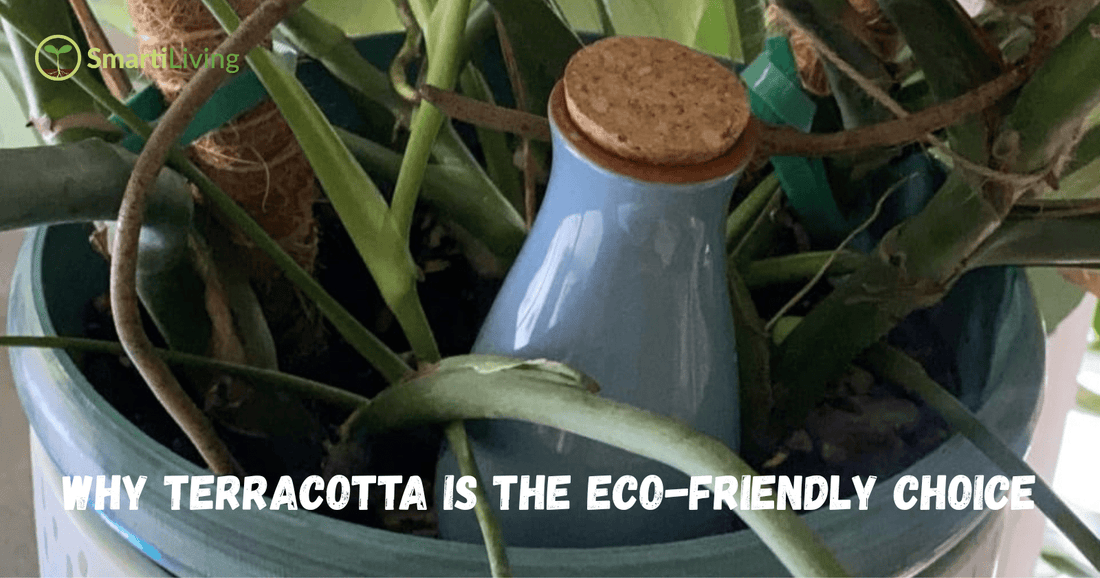
Why Terracotta is the Eco-Friendly Choice for Self-Watering System
Share
The Sustainable Advantage of Terracotta Self-Watering Systems
As more gardeners embrace eco-conscious practices, terracotta self-watering spikes and ollas have emerged as the top sustainable solution for plant care. Unlike plastic alternatives, terracotta—a natural, porous clay—provides gentle, consistent hydration while minimizing water waste and environmental impact.
In this guide, we’ll explore:
✔ Why terracotta is the most eco-friendly self-watering material
✔ Key benefits over plastic and glass watering systems
✔ How to use terracotta spikes & ollas for sustainable gardening
✔ Why SmartiCulture’s terracotta spikes lead the market
Why Terracotta is the Greenest Choice for Self-Watering
1. Made from 100% Natural, Biodegradable Clay
- Terracotta is crafted from earth clay and water, requiring minimal processing.
- Unlike plastic self-watering stakes, it breaks down naturally without microplastic pollution.
- Production uses less energy than synthetic materials.
2. Saves Water with Smart Porosity
- Terracotta’s microscopic pores release water only when soil is dry, preventing overwatering.
- Reduces water usage by up to 70% compared to manual watering.
- Ideal for drought-prone areas and eco-conscious gardeners.
3. Plastic-Free & Non-Toxic
- Most self-watering globes and spikes are plastic, which can leach chemicals into soil.
- Terracotta is chemical-free and safe for organic gardening.
4. Energy-Free Operation
- No batteries, electricity, or moving parts—just natural capillary action.
- More reliable than automatic drip irrigation systems.
Terracotta vs. Other Self-Watering Materials
| Feature | Terracotta | Plastic | Glass |
|---|---|---|---|
| Eco-Friendliness | ✅ 100% natural | ❌ Petroleum-based | ⚠️ Energy-intensive |
| Water Efficiency | ✅ High (slow seep) | ❌ Often overflows | ⚠️ Fast evaporation |
| Durability | ✅ Years of use | ❌ Brittle over time | ❌ Breaks easily |
| Root Health | ✅ Prevents rot | ❌ Can suffocate roots | ⚠️ Uneven watering |
How to Use Terracotta Self-Watering Spikes
Step 1: Soak Before Use
- Submerge spikes in water for 15 minutes to activate porosity.
Step 2: Fill & Insert
- Spike Drip Jars: Fill the attached reservoir for weeks of watering.
- Classic Bulbs: Bury near roots for steady moisture.
Step 3: Monitor & Refill
- Check water levels weekly (varies by plant needs).
- Clean mineral deposits with vinegar soak every few months.
Why Choose SmartiLiving Terracotta Spikes?
🌿 Spike Drip Jars – Large reservoirs for low-maintenance care.
🌿 Bulb Models – Perfect for small pots and herbs.
🌿 Sleek Design – Blends into indoor and outdoor gardens.
Final Verdict: Terracotta Wins for Sustainability
For gardeners who value eco-friendliness, water conservation, and plant health, terracotta self-watering systems are the clear winner. Ditch plastic globes and embrace nature’s original irrigation tool!
Ready to go green? Try SmartiLiving terracotta spikes for a truly sustainable plant-care solution.
